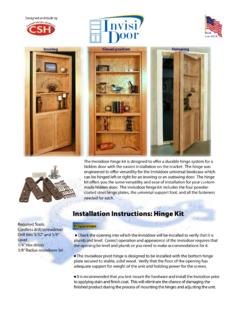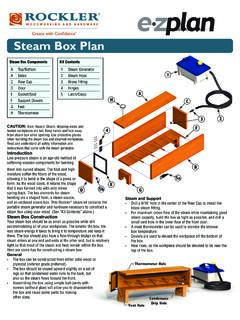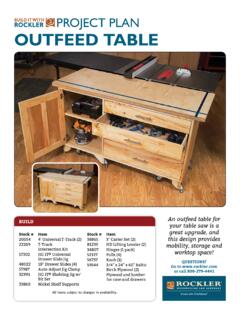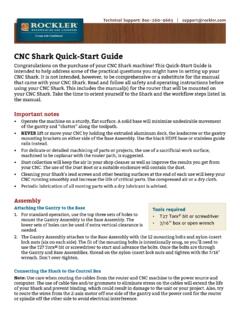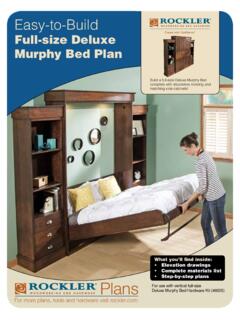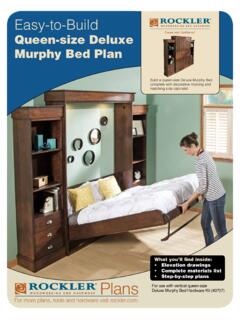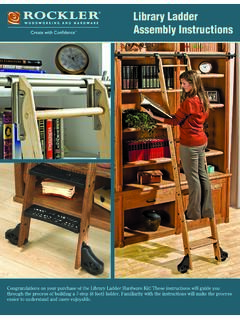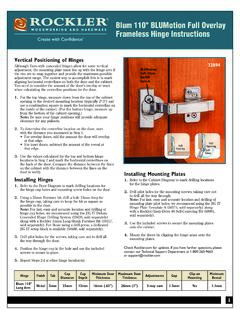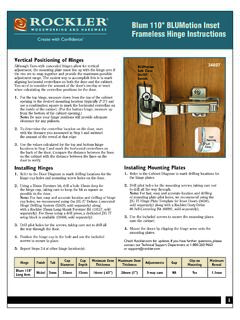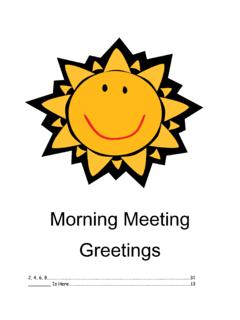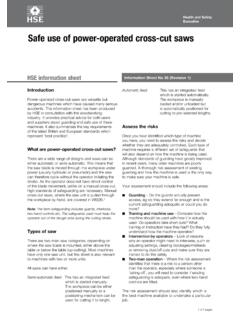Transcription of Lift Top Coffee Table - Rockler Woodworking and Hardware
1 Lift Top Coffee TableBevelishCreations - Alex Fang and Materials11 Bottom Panel3/4 x 27 5/8 x 50 2 Side Panel (x2)3/4 x 27 5/8 x 8 3 Long Front & Back Panels3/4 x 34 x 7 1/2 4 Divider3/4 x 27 5/8 x 7 1/2 5 Short Front & Back Panels (x2)3/4 x 16 1/4 x 7 1/2 6 Bottom Panel Edge Banding (x2)1/8 x 50 x 3/4 7 Side Panel Short Edge Banding (x4)1/8 x 8 1/8 x 3/4 8 Side Panel Long Edge Banding (x3)1/8 x 27 5/8 x 3/4 9 Long Front & Back Edge Banding (x2)1/8 x 33 1/2 x 3/4 10 Divider Short Edge Banding (x2)1/8 x 7 3/8 x 3/4 11 Fixed Top3/4 x 12 x 35 12 Long Lift Top3/4 x 15 3/4 x 35 13 Short Lift Top3/4 x 16 3/8 x 27 7/8 14 Leg Rails (x4)1 1/4 x 25 3/8 x 1 5/8 15 Leg Stiles (x4)1 1/4 x 8 1/2 x 1 5/8 16 Leg Stretchers (x3)1 1/4 x 48 1/4 x 1 5/8 2233455667777889981010111213141414141515 1515161616 IntroductionMy wife and I love watching movies and TV together on the couch.
2 So it s no surprise we get a lot of use out of our living room. But that also means we like eating our meals in front of the TV and do computer work on the couch as well. A lift top Coffee Table would be the perfect addition to our home. Now we can eat in front of the TV by lifting the Coffee Table top to just the right height. No more sitting awkwardly on the floor and risk spilling drinks. The lift top also makes it more convenient to do work on the couch, while having the TV on. This Coffee Table features two lift tops, perfect for multiple members in the family, and a great fit for livingrooms with the caseThe case is made from 3/4 walnut plywood, wit h 1/8 hardwood edgebanding. I will start by breaking down the plywood for the bottom and two side panels to their final sizes. And I will cut the rest of the pieces slightly oversized for easier handling.
3 1. Cut bottom panel down to its final Use Rockler Crosscut Sledto cut side panels down to I will rip 1/8 pieces of hardwood to slightly more than 3/4 wide for edge banding. The strips will be cut longer than the length of the panels as well. I ll flush up the strips to the panels later. The bottom panel will receive two pieces of edgebanding along the long edges, and the two side panels will both receive edge banding on three of the four edges. The strips will be attached to the panels using glue and bandy Use MicrojigGrrripperto rip 1/8 hardwood into strips166277827784. Use Rockler glue brush applicatorto apply glue along the plywood edges5. Use medium Rockler Bandy Clamps to hold the edge banding downOnce the glue has cured, I used a flush trim saw and a block plane to flush the edgebanding to the Use SuizanFlush Trim Sawto cut the edgebandsto length7.
4 Use a block plane to flush up the edges of the trim to the top and bottom surfaces of the panelAfter the edgebanding are flushed up, it s time to cut the joinery. I used a 23/32 plywood router bit in my router to cut the dados. I pushed the two side panels against the bottom panel with their edges flush against each other. Then made the cuts with a single pass. This ensures the dados will line Use Festool1400router and 23/32 router bit to cut the dados15 5/8 7/8 7/8 10 1/8 Next, I m going to prepare for assembling the three sides of the case. I will be using dowels to add strength and help with alignment. First, I will place the side panels on the correct side of the bottom panel, then make sure the edges are flush against each other and clamp them down. This will ensure the panels will not move as I begin laying down the locations of the dowels.
5 I will place the first dowel about 3/4 from the edge of the dado, and then the rest will be spaced roughly 3 apart. Once I ve made the marks, I will use a square to strike a line through both panels at each of the marks. This will h elp to ensure the layout lines will line up perfectly between both Use a tape measure to space out the dowels11. Use a square to strike a line through both panels, at each of the layout marksNow, it s time to set up the Rockler Doweling Jig. Since I am building the case out of 3/4 panels, I will use 3/8 dowels for this. The jig has a depth gauge engraved in the back to help me quickly set up the drill bit. Since the dowels are 1 long, I set up the depth to 1/2 , and then tightened the stop Use the depth gauge on the doweling jig to set up how deep to just line up one of the reference marks on the jig to one of the layout lines we made to start drilling.
6 It is straightforward for the bottom panel since the dowel holes will be drilled along the edge, the reference surface will be the top surface. But since we ll be drilling into the to p surface of the side panels, the reference surface will have to be the edge. So a longer clamp will be needed to clamp the jig to the work piece. This is whe re a vise will come in handy if you have one. 13. Using the Rockler One-Handed Bar Clampto hold the jig to the bottom panel surface14. Drill dowel hole using the 3/8 bit included in the Rockler 3/8 Doweling Jig15. Use a vise or the Rockler Sure-foot F-style clamp to hold the doweling jig against the edge of the side panels16. Drill into the surface of the side all the dowel holes are drilled, it s time to insert the dowels. I ll start by applying a bead of glue along the dowel and inserting them into the holes along both edges of the bottom panel.
7 Then apply glue along the bottom edges of both side panels and make sure to get some glue into the dowel holes as well. Then just bring the side panels and the bottom panel together. As long as you ve taken the time to layout the reference lines previously, these panels should come together with ease. 17. Using the Rockler Glue Brush Applicator to apply glue along the dowel18. Insert dowels along both edges of the bottom panel19. Apply glue along the bottom edge of the side panels. Make sure to get glue into the dowel Bring the side panel and the bottom panel clamp the case together using clamps. Since only three panels are being glued together in this step, it s important to use clamping squares to ensure everything is at 90 as the glue cures. 21. Using Rockler Sure-Foot Aluminum Bar Clamps to hold the side panels together to the bottom panel22.
8 Use the Rockler Clamp-It Square with Rockler Universal Fence Clampsto hold the panels square 23. Cut 3/4 x 1/4 notches on the bottom corners of the divider24. Attach the divider to the bottom panel using glue and clampsAfter the glue has had some time to cure, I came back to cut the divider to size and cut the dados into the panel to match tho se on the bottom panel. I cut 3/4 x 1/4 notches on the bottom corners of the divider to allow the front and back edges to sit flush to the bottom panel edges. If yo u prefer the look of dados, feel free to cut the dado all the way through on the bottom panel. Then, just apply glue in the dado of the bottom panel and attach the divider. Once again, I used clamping squares to help ensure the piece is 90-degrees. I also used a long piece of offcut as a caul to help with spreading out the clamping pressure along the entire piece since I cannot get clamps to the middle of the With the sides and the divider glued in place, I can measure between the dados and cut the front and back pieces to size.
9 Then, just slide the pieces into the dados, apply glue, and clamp them Use the Rockler C rosscut Sled to cut the front and back panels to size26. Slide the long front and back panels into the dados27. Slide the short front and back panels into place28. Use glue and the Rockler Sure-Foot Aluminum Bar Clamps to attach everything together29. Use the Rockler Crosscut Sled to cut the lumber to their rough lengths30. Use the jointer to flatten one face and square up one edge31. Use the planer to flatten the second face and bring the pieces down to their final thicknesses32. Square up 2ndedge on the Table sawMaking The TopThe top will consist of three separate panels made from 4/4 walnut hardwood. I chose not to use plywood for the top because the top will likely be used a lot, so I want it to be able to stand up to some level of abuse.
10 I will also cut finger grooves to the bottom to help wit h holding the top whe n opening it, and I don t want the plywood edges to show. To begin making the top panels, I will first cut the 4/4 lumber down to their rough lengths to make it easier to handle. Then I will run them through the jointer to flatten one face, and square up one edge. Next , I ll r un them through the planer to flatten the second face and bring the pieces down to their final thicknesses. Finally, I ll r un them through the Table saw to square up the second edge, before gluing them up to form larger Apply glue along the edges of the panels34. Use Rockler Sure-foot Aluminum Bar Clampsfor panel glue-up35. Cut panels down to their final size at the Table saw36. Position the fixed top on to the caseAfter leaving the pieces glued up for a few hours, I came back later that day to cut them down to their final sizes.
